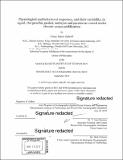| dc.contributor.advisor | T. Aran Mooney. | en_US |
| dc.contributor.author | Zakroff, Casey James. | en_US |
| dc.contributor.other | Joint Program in Oceanography/Applied Ocean Science and Engineering. | en_US |
| dc.contributor.other | Massachusetts Institute of Technology. Department of Biology. | en_US |
| dc.contributor.other | Woods Hole Oceanographic Institution. | en_US |
| dc.date.accessioned | 2020-02-10T21:38:12Z | |
| dc.date.available | 2020-02-10T21:38:12Z | |
| dc.date.copyright | 2019 | en_US |
| dc.date.issued | 2019 | en_US |
| dc.identifier.uri | https://hdl.handle.net/1721.1/123719 | |
| dc.description | Thesis: Ph. D., Joint Program in Oceanography/Applied Ocean Science and Engineering (Massachusetts Institute of Technology, Department of Biology; and the Woods Hole Oceanographic Institution), 2019 | en_US |
| dc.description | Cataloged from PDF version of thesis. | en_US |
| dc.description | Includes bibliographical references (pages 257-278). | en_US |
| dc.description.abstract | Ocean acidification (OA) and related stressors, like warming, are occurring rapidly in coastal systems. There is concern about the impacts these stressors may have on the early development of species that use the nearshore as nursery habitat. The inshore longfin squid, Doryteuthis pealeii, plays an important role in the northwest Atlantic food web, and annually lays its eggs in the nearshore benthos during summer. This thesis sought to characterize morphological, physiological, and behavioral responses of D. pealeii embryos and paralarvae to OA. Experiments began in 2013, where I exposed squid eggs to a range of acidification levels (400 2200 ppm CO₂) to uncover when the dosage impacts first appear (around 1300 ppm). To do this, I developed multiple methods to better characterize the morphological changes and surface degradation of statoliths dueto acidification. | en_US |
| dc.description.abstract | This initial work demonstrated small-scale variability in response intensity, across hatching days and the breeding season. I ran swimming behavior experiments with subsampled paralarvae from 2013 - 2015 and developed a novel 3D recording and analysis tracking system in the process. The 2D data from 2013 showed significant decreases in time spent near surface, while 3D data in subsequent years showed slight impacts to activity and swimming velocity with increasing acidification. Overall, I ran experiments from 2013-2016, and compiled and compared these data using response ratios. I show that seasonal temperatures impact the baseline state of the paralarvae through parental condition, while acidification sensitivity appears driven by parental year class. Finally, I examined the interaction of acidification stress with warming, demonstrating an antagonistic relationship between these stressors for this life stage of this squid. | en_US |
| dc.description.abstract | These data indicate that acidification builds as a stressor, impacting late stages of embryonic development, while warming impacts embryos early in development, and likely reduces acidification impacts by decreasing development time. This dissertation demonstrates that while the embryonic and paralarval stages can be sensitive to acidification, being so highly fecund and varying in resistance at multiple temporal scales alows for a substantial potential for resilience to a changing ocean in this population of squid. | en_US |
| dc.description.sponsorship | "The National Science Foundation provided funding for this project under Grant No. 1220034 to Aran Mooney. The Woods Hole Oceanographic Institution also funded research presented in this dissertation through the Coastal Ocean Institute and Grassle Family Foundation awards. The National Science Foundation Graduate Research Fellowship provided tuition and stipend support under Grant No. 1122374. The Hugh Hampton Young Memorial Fund Fellowship provided through the MIT Office of Graduate Education also provided tuition and stipend support, as did the Academic Programs Office of the Woods Hole Oceanographic Institution. The Mindlin Foundation, through their OneTweetOnePercent award, and the Academic Programs Office of the Woods Hole Oceanographic Institution provided support for time pursuing outreach and science communication projects"--Page 7 | en_US |
| dc.description.statementofresponsibility | by Casey James Zakroff. | en_US |
| dc.format.extent | 278 pages | en_US |
| dc.language.iso | eng | en_US |
| dc.publisher | Massachusetts Institute of Technology | en_US |
| dc.rights | MIT theses are protected by copyright. They may be viewed, downloaded, or printed from this source but further reproduction or distribution in any format is prohibited without written permission. | en_US |
| dc.rights.uri | http://dspace.mit.edu/handle/1721.1/7582 | en_US |
| dc.subject | Joint Program in Oceanography/Applied Ocean Science and Engineering. | en_US |
| dc.subject | Biology. | en_US |
| dc.subject | Woods Hole Oceanographic Institution. | en_US |
| dc.subject.lcsh | Ocean acidification. | en_US |
| dc.subject.lcsh | Ocean temperature. | en_US |
| dc.subject.lcsh | Habitat (Ecology) | en_US |
| dc.subject.lcsh | Squids. | en_US |
| dc.title | Physiological and behavioral responses, and their variability, in squid, Doryteuthis pealeii, embryos and paralarvae reared under chronic ocean acidification | en_US |
| dc.type | Thesis | en_US |
| dc.description.degree | Ph. D. | en_US |
| dc.contributor.department | Joint Program in Oceanography/Applied Ocean Science and Engineering | en_US |
| dc.contributor.department | Massachusetts Institute of Technology. Department of Biology | en_US |
| dc.contributor.department | Woods Hole Oceanographic Institution | en_US |
| dc.identifier.oclc | 1138021643 | en_US |
| dc.description.collection | Ph.D. Joint Program in Oceanography/Applied Ocean Science and Engineering (Massachusetts Institute of Technology, Department of Biology; and the Woods Hole Oceanographic Institution) | en_US |
| dspace.imported | 2020-02-10T21:38:09Z | en_US |
| mit.thesis.degree | Doctoral | en_US |
| mit.thesis.department | Bio | en_US |
